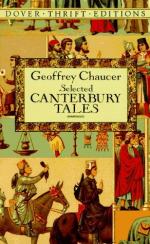|
|
The Canterbury Tales Topic Tracking: Violence
Violence 1: As Theseus and his soldiers go to Thebes to fight, they engage in acts of violence. As simple as this tale is told, men fight and kill other men. This is the first mention of violence throughout the tales and certainly not the last. They are full of fighting and death. In this instance of violence, Theseus and his soldiers defeat Thebes quickly, in order to move on to other violent acts.
Violence 2: Arcite and Palamon decide to battle for Emelye's hand in marriage. Their battle involves fighting, violence, swords, and possibly death. This battle is thrown together fairly quickly, for it was common to fight for love and use violence to reach a conclusion at that time.
Violence 3: The battle between Palamon and Arcite involves swordplay, thrashing, striking, and ultimately death. This violent display of affection is typical of men wooing women in medieval times.
Violence 4: Although not direct violence, as in a duel or battle, the violence enacted in the Miller's Tale is accomplished through deception. When Absolon burns Nicholas's rear end, he is taking a small hot iron and slightly violently inflicting pain. And when the tub falls from the roof, injuring John, he is violently embarrassed and hurt by the fall. The violence in this tale stems not from sword fighting and battle play, but from small jokes and personal attacks.
Violence 5: The Reeve's Tale involves violence on a more personal level. Towards the conclusion, Symkyn fights with Aleyn after he discovers the sexual behavior that occurred during the night, while the miller's wife attempts to join the battle to help her husband, but unfortunately strikes him doing so. Her ribs are broken, he is struck, and the two students escape nonetheless. The small battle in the miller's house resulted in minor violence and injury and illustrates that violence exists not only on the battlefield.
Violence 6: The Sultana's great feast in the Man of Law's Tale yields much violence in a single command of action. She has everyone at the feast killed in a great massacre, except Constance, to prove a point and to allow Constance to return home. This violent mass murder is a small event in the tale that houses much more violence.
Violence 7: The knight enamored with Constance violently kills Dame Hermengild by slitting her throat. He frames Constance for this crime and is sentenced to death, another act of violence.
Violence 8: The warden's steward comes aboard the boat in which Constance is banished and attempts to rape her. Although no blood is spilled, a rape is an act of violence, which at this time in history may not have been considered violence, but is certainly now a violent criminal act. The attempted rapist dies by drowning.
Violence 9: The Wife of Bath tells of her fifth husband, Jankin, and his physical domestic abuse. He hit her on the ear so hard one time that she lost hearing on that side forever. This small violent act between a husband and wife was probably common at the time, but the Wife of Bath discusses it as if it were horribly violent and unusual. While his maltreatment of her is violent, the Wife of Bath used it to get what she wanted from him in the end.
Violence 10: Again, rape is the act of violence in this tale. A knight finds a maiden walking alone and simply decides to rape her. He is taken to the king and has one year to free himself from punishment by death if he can discover what women truly desire. Although the tale does not surround the violent act, it does set the catalyst for the tale to ensue.
Violence 11: This instance of small violence is not from one of the tales, but rather from the pilgrims themselves. The Friar and Summoner have problems with one another and begin to fight. The host eventually pulls them apart and tells the Friar to begin his tale of an unlawful summoner.
Violence 12: The violence in this tale is self-inflicted and brought upon by selfish avarice. The three rioters, in an attempt to become rich, killed themselves and each other. The two rioters stabbed the third to death in a violent and brutal attempt to win more money for themselves. However, soon after their supposed victory for more money, they drank the poisoned wine and died as well.
Violence 13: The Jew in this tale violently cuts the throat of the young boy singing to the Virgin Mary. Instead of simply hitting him or scolding him, the tale dictates that the Jew violently kills the young boy with a knife. Any type of murder is considered violence, and as seen throughout the tales, there is massacre, murder, and violent deaths dispersed in these pages.
Violence 14: Melibeus's daughter, Sophie, was brutally murdered in five places on her body: feet, hands, ears, nose, and mouth. This violent death is, again, fairly typical in these tales. However, despite the gruesome murder of this young woman, revenge seems to overtake the violence. Sophie miraculously comes back to life after her brutal murder, which is another common theme in the tales. Innocent victims of violence are often reborn because of religious or philosophical worship.
Violence 15: Cecilia's death is described in violent terms and was a brutal procedure of torture. She was burned, slashed, and hit, and still never killed. She eventually died by way of desolation with her wounds. Her violent death made her a martyr for Christianity.




